|
Classic Airframes'
1/48 Mőlders
Messerschmitt Bf 109D
by Lynn Ritger
|
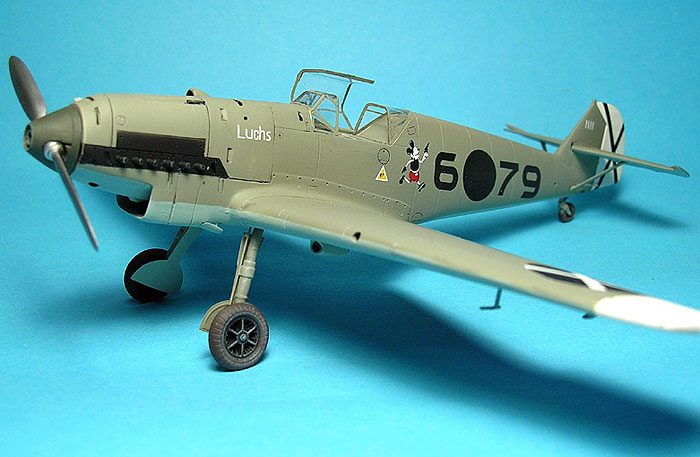 |
|
Messerschmitt
Bf 109D-1
Ltn. Werner Mölders, 3./J88, La Cenia, Spain, Late July,
1938 |

Classic Airframes' 1/48 scale Messerschmitt Bf 109
D is available online from Squadron
For a detailed examination of the
contents of
Classic Airframes' 1/48 scale Messerschmitt Bf 19C/D kit, see the
review elsewhere on HyperScale
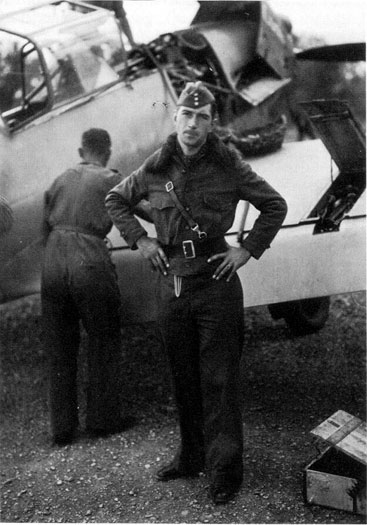 Hailing from
Gelsenkirchen, just northeast of Essen in the Ruhr, Werner Mölders
joined the German army in 1931 and served for three years as an
infantry officer cadet before being granted a transfer to the
nascent Luftwaffe in 1934. His path to flight school was not as
successful as one might expect; he failed his first entry exam, but
was eventually accepted on his second try after forcing himself to
not become airsick. Following his training and obtaining his pilot's
certificate, he was initially posted to Fliegergruppe Schwerin on 1
July 1935, flying Heinkel He 51Bs under the command of Maj.
Hans-Hugo Witt. By April 1936, he had shown sufficient flying skill
and leadership aptitude to be designated an instructor with JG 134
at Dortmund. Hailing from
Gelsenkirchen, just northeast of Essen in the Ruhr, Werner Mölders
joined the German army in 1931 and served for three years as an
infantry officer cadet before being granted a transfer to the
nascent Luftwaffe in 1934. His path to flight school was not as
successful as one might expect; he failed his first entry exam, but
was eventually accepted on his second try after forcing himself to
not become airsick. Following his training and obtaining his pilot's
certificate, he was initially posted to Fliegergruppe Schwerin on 1
July 1935, flying Heinkel He 51Bs under the command of Maj.
Hans-Hugo Witt. By April 1936, he had shown sufficient flying skill
and leadership aptitude to be designated an instructor with JG 134
at Dortmund.
Several hundred miles to the southwest, an exiled Spanish general by
the name of Francisco Franco had launched a military operation to
wrest control of Spain from the corrupt and unresponsive government.
After a personal plea to Adolf Hitler for aid, the initial cadré of
German "tourists" and equipment arrived at the port of Cadiz on 6
August 1936 and moved north to Seville to aid Franco's embattled
Nationalist forces. This conflict would be used as a proving ground
for German forces and tactics, and it would be over the sun-bleached
Iberian landscape that Werner Mölders would first make history.
Having spent the better part of two years as an instructor, Leutnant
Mölders volunteered to go to Spain and finally arrived on 14 April
1938. As he had extensive leadership experience, he was tapped to
replace Adolf Galland as the leader of 3./J88 which was currently
based at La Sénia, on the border between Cataluña and Comunidad
Valenciana.
He was assigned a relatively new Bf 109D-1 coded 6-79 upon his
arrival which soon carried the nickname "Luchs" (lynx), and it was
only a matter of time before he scored his first victory, an
aircraft he listed as a "Curtiss" which he shot down on 15 July near
Algar. He scored another two victories on the 17th and 19th, but had
to wait another month before downing his fourth aircraft, an I-16 "Mosca"
on 19 August. At this point the Republican army offensive along the
Ebro river front was reaching a crescendo, and furious fighting
ensued over the next two months.
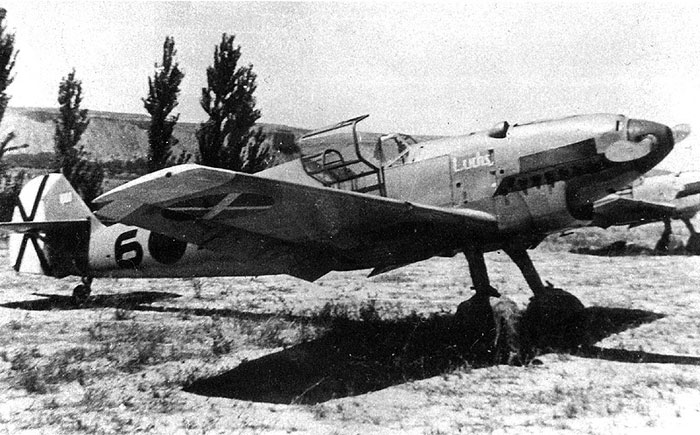
By 31 October, Mölders' score stood
at 13, the majority of which were I-16s, and he scored his last
confirmed victory in Spain on 3 November- once again over a portly "Mosca".
He would return to Germany as the most successful fighter pilot of
the Legion Condor, and was showered with awards and praise for his
accomplishments over Spain. Mölders would later become the most
celebrated military figure in Germany as he was the first pilot to
surpass Manfred von Richthofen's tally of eighty victories, and he
would also become the first fighter pilot in history to claim 100
aircraft, a feat accomplished on 15 July 1941 over Russia.
As a soldier, Mölders was among the best Germany ever produced, but
it was his strengths as a man which have caused his name to be
revered to this day. A devout Catholic and loyal husband, he did his
absolute best to serve his country, even as his doubts about the
government grew.
Tragically, he was killed in a strange accident on
22 November 1941- he was enroute back to Germany to serve as a
pallbearer for Generaloberst Ernst Udet who had committed suicide
several days previously, and the Heinkel He 111H in which he was a
passenger suffered a double engine failure whilst in the landing
pattern for Breslau airfield. The aircraft hit a factory smokestack
and crashed, killing Mölders and the pilot, while two other men
survived with wounds.
In recent years there have been theories that
the German government may have orchestrated the death of their
greatest pilot because of some hard questions he was beginning to
ask about their conduct, although to date there has been no hard
evidence supporting this theory.
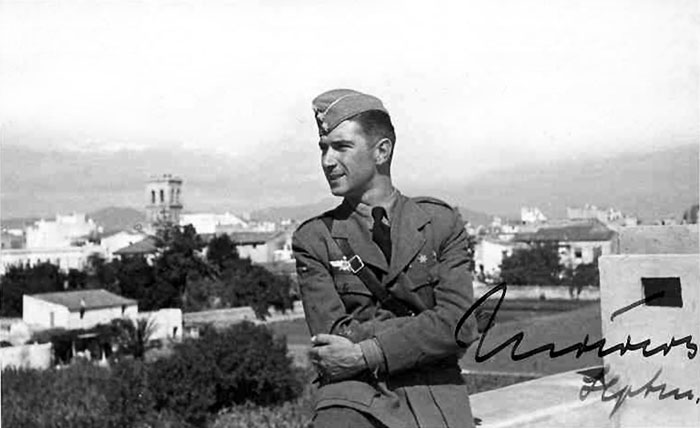
Mölders' name was carried by his
unit, JG 51, throughout the remainder of WW2 and is still in use
today with JG 74. There was also an Adams-class destroyer named for
him, which was retired in 2003 and is now on display in
Wilhelmshaven.
The original Classic Airframes Bf 109 kit released at the beginning
of 2006 was a very early A/B variant, with the long slats, inboard
oil cooler, and no wing guns. This boxing features reworked wings
with the more common short slat configuration along with the MG 17
access panels and ejection chutes in the wings, along with the
outboard mounted oil cooler. A choice of cowlings is once again
given, which is a tremendous boon to those of us with multiple old
Hobbycraft kits in the stash waiting for some help for their
misshapen noses!
One small detail to watch out for is the position
of the oxygen filler and 24 volt ground power plug... the kit
fuselage retains these features in the location of the earlier A/B
series, and you will need to fill and rescribe the hatches in
fuselage station 3 on the starboard side.
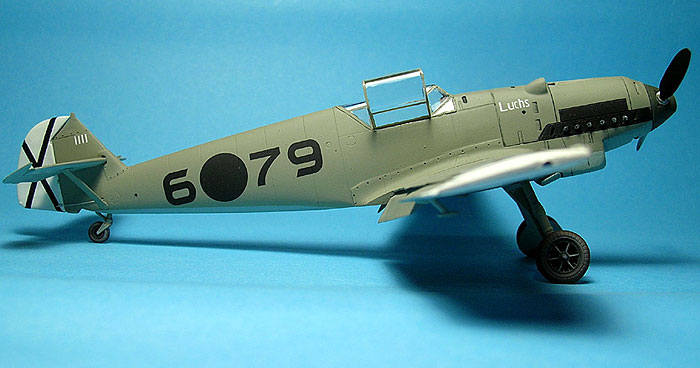
Kit construction has been amply covered in other reviews, and the D
kit introduces no new surprises for the unwary builder; just take
care to align all the nose components through dryfitting and careful
sanding and filing.
Several decal options are given in the kit, including two Swiss
options, a Hungarian D, and two of the most recognizable aces to
emerge from the Spanish Civil War- Gotthard Handrick and Werner
Mölders. I chose the latter option, and began digging into the
history of the aircraft. Mölders' D-1 was coded 6-79, one of the
last D models sent to Spain prior to the introduction of the far
more powerful Bf 109E, and as such there was little ambiguity about
the color scheme... it was painted in 63 over 65, not 62 as has
recently been theorized. The sole remaining Spanish Civil War-era
109 still carrying traces of it's original camouflage was being
offered for sale recently, and thanks to the cooperation of the
seller, I was able to obtain very close photos of the remaining
paint areas which were grey, not green. (Plug: for more information,
see my book "Modellers Datafile No. 9, Messerschmitt Bf 109 -
Prototypes through E series", available through SAM Publications).
63 was a warm, slightly greenish grey which was very close in tone
to RLM 02, so not wanting to complicate things I just used plain
Testor Model Master 02 over 65 and was plenty happy with the result.
The wingtips and rudder were painted in plain old Testor white from
the small square bottle, and then it came time to make a decision on
the propeller spinner.
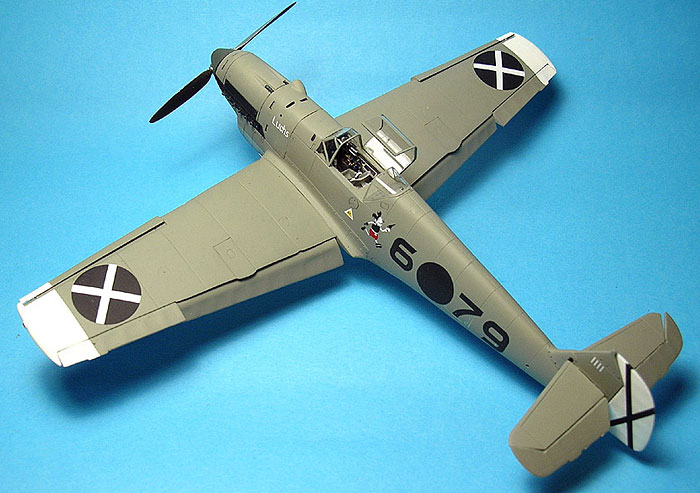
There is one photo from late August 1938 showing 6-79 with four
victories (following Mölders' claim on 19 August) which shows the
spinner in a distinctly different tone from that of the airframe...
but what color was it? The artist of the superb box art piece, Jerry
Boucher, hypothesized red, and the tonal contrast does seem to fit.
However, red was the Staffel color of 2. Staffel, and Mölders was
the Staffelkapitän of 3. Staffel... so it's unlikely he'd have
another unit's color on his aircraft. 3. Staffel aircraft were
sometimes seen with yellow spinners (their unit color), but this
photo seems a bit too dark for yellow. So, I went with plain
Aeromaster Dunkelgrün 71, simulating a faded 70 spinner as I felt
this was the most likely option. The fronts of the prop blades were
painted with Floquil Old Silver, burnished with Hawkeye Designs'
aluminum polishing powder, while the rear was painted black.
Decaling was an absolute cinch, although here again I'd like to give
a slight heads up about stenciling. As evidenced in photos, Mölders'
aircraft did not carry any wing walk markings so do not use either
of the options given on the decal sheet. Final assembly included
adding the slightly modified landing gear assemblies and tail struts
(which virtually snapped into place... a welcome surprise), and
after a few thin coats of Dullcoat and removal of the canopy
masking, it was done.
I chose not to weather the aircraft at all, as
6-79 was kept in immaculate condition by Mölders' ground crew, and
I'm thrilled with the model's final appearance. It looks great
parked next to my earlier Bf 109A coded 6-3, and I can see several
more of these excellent kits being added to the collection!
Many
thanks to Classic Airframes for the review sample.
Click
the thumbnails below to view larger images:
[../../photogallery/photo00001409/real.htm]
Model and Images Copyright © 2007
by Lynn Ritger
Page Created 09 August, 2007
Last Updated
24 December, 2007
Back to
HyperScale Main Page |
Home
| What's New |
Features |
Gallery |
Reviews |
Reference |
Forum |